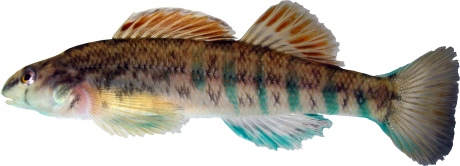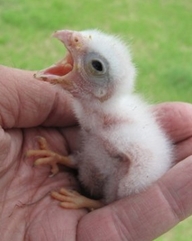Noteworthy
 Another 320 acres along Raccoon Creek tributaries in Paulding County will be protected, benefiting federally listed Etowah and Cherokee darters, as well as other wildlife. A $116,578 federal Recovery Land Acquisition Grant will help DNR acquire the tract rated critical for the long-term survival of the rare darters and also providing needed connectivity to other protected areas in the watershed, according to the U.S. Fish and Wildlife Service. The acquisition, which will become part of Paulding Forest Wildlife Management Area, was announced as part of nearly $35 million in federal grants for states’ collaborative efforts to conserve imperiled species. Project list.
The 2014 State of the Birds report released this week shows that many species found in Georgia are on the watch list – such as cerulean warblers, declining by 3 percent a year – while the state also shares in some conservation success stories, including the increase in American oystercatcher populations. One take-home message: Proactive conservation is the most effective way to keep common species common and less common ones from needing Endangered Species Act protection.
The first Bat Blitz by the Georgia Bat Working Group had bats and bat lovers galore last weekend at Black Rock Mountain State Park. As part of a national effort to survey bats during the same week, some 60 people netted 18 sites on the park and surrounding public lands, capturing 123 bats, from 99 red bats to one northern long-eared bat, a candidate species for federal listing.
Have satellite, will travel – and even provide data! Mottled ducks, which began showing up on the Georgia coast in the late 1990s, are being outfitted with satellite transmitters in an effort by the University of Georgia and DNR’s Wildlife Resources Division to learn more about the ducks’ habitat preferences and movement patterns, data that will help DNR manage coastal impoundments.
Georgia rockress, a perennial herb numbering about 5,000 plants and found only in Georgia and Alabama, will be listed as threatened under the Endangered Species Act, according to the U.S. Fish and Wildlife Service. The listing and the designation of 732 acres of habitat as critical – including in Georgia’s Gordon, Floyd, Harris, Muscogee and Clay counties – becomes effective Oct. 14.
About 1,500 acres in Georgia, Alabama and Tennessee will be designated as critical habitat for the endangered whorled sunflower. All of the critical habitat in Georgia is in Floyd County, owned by Plum Creek and protected by a conservation easement held by The Nature Conservancy.
What was Smithgall Woodland Garden is now Atlanta Botanical Garden, Gainesville. With the blessing of donor Lessie Smithgall, leaders decided to rename the 168-acre site in north Gainesville to emphasize its connection with Atlanta Botanical Garden – which is building the garden and will run its programs – and to avoid confusion with Smithgall Woods State Park near Helen.
 Southeastern American kestrels in middle Georgia’s Fall Line sandhills declined about 7 percent a year, with steep drops in the raptors' use of nest boxes, DNR aerial surveys from 2010-2014 show. Yet, Nongame senior wildlife biologist Nathan Klaus says surveys also revealed that a south Georgia kestrel population found along a powerline corridor from Georgia Power’s Plant Mitchell near Albany to Offerman in Pierce County grew 17 percent a year to 302 nesting pairs, possibly because the birds took advantage of nest sites provided by older powerline structures.
In other bird news, Berry College has revealed that a second bald eagle nest on campus – not the one made famous by the school’s live-streaming cams – produced three eaglets this spring. Also, a project pushing the passenger pigeon documentary “From billions to none” on public television has taken off.
Some 3,200 lake sturgeon fingerlings were released into the Conasauga River in Whitfield County this week by DNR fisheries staff. Started in 2002 in northwest Georgia rivers, the sturgeon releases are aimed at re-establishing these unique fish in their native range. Learn more.
Want to go to BOW? The deadline for a scholarship to attend the Becoming an Outdoors-Woman program Nov. 7-9 at Charlie Elliott Wildlife Center in Mansfield has been extended to Oct. 10. Apply.
Salamanders and wolf spiders have this in common: Both are key predators. Research shows that salamanders could be affecting carbon levels by eating bugs that shred leaves and thus release carbon and methane, while UGA scientists have discovered that wolf spiders are taking advantage of cover provided by invasive Japanese stiltgrass to prey on American toads, undercutting toad survival rates.
|
 Names in the news: The DNR Law Enforcement Division named Cpl. Greg Wade of Tift County as 2014 Ranger of the Year, and Cpl. Jeremy Bolen of Muscogee and Talbot counties as runner-up. DNR Commissioner Mark Williams said both men exhibit the “common characteristics of leadership, teamwork, dedication and a willingness to do whatever it takes to get the job done.”
Clarification: DNR's Mincy Moffett took the Aug. 25 Georgia Wild photograph of Shan Cammack installing a sign at Ohoopee Dunes Wildlife Management Area.
Coming up:
Sept. 19-21 – Women in the Outdoors, Georgia FFA Center, Covington.
Sept. 25 – Georgia Prescribed Fire Council annual meeting, Tifton.
Sept. 27 – Help plant native wildflowers at grassland restoration site (as part of State Parks Day), Panola Mountain State Park, Stockbridge. Call to pre-register, (770) 389-7801.
Sept. 27 – Your State Parks Day, free admission to Georgia’s State Parks & Historic Sites, statewide.
Oct. 3 – Outdoor Learning Symposium, Environmental Education Alliance of Georgia, Chattahoochee Nature Center, Roswell.
Oct. 4 – 20th Anniversary CoastFest, DNR Coastal Regional Headquarters, Brunswick
Oct. 16-18 – 36th annual Gopher Tortoise Council Conference, Chehaw Park, Albany.
Oct. 21-24 – 10th Biennial Longleaf Conference, Ninth Eastern Native Grass Symposium and National Prescribed Fire Council meeting, Mobile, Ala.
Nov. 7-9 – Fall BOW program (Becoming an Outdoors-Woman), Charlie Elliott Wildlife Center, Mansfield. (Deadline to apply for a BOW scholarship: Oct. 10.)
Back to top.
Headlines
"U.S. gets middling marks on 2014 'State Of Birds' report card," NPR (audio)
"Garbage may be to blame for Florida whale's death," WXGA-TV (Macon) (and others via AP)
"Labor Day holiday signals end to sluggish sea turtle nesting season," The Augusta Chronicle (and others via AP)
"Emerging disease confirmed in wild Bulloch County snake," Statesboro Herald
"Georgia science teachers encouraged to apply for grant," Valdosta Daily Times (and others via AP)
"Sick gopher tortoises are unusually mobile, could be leading to disease spread, study finds," (citing DNR's Dr. Jessica McGuire) phys.org
"DNR honors Wade as ‘Ranger of the Year,'" WJCL-TV (Savannah)
"Gainesville botanical garden renamed," The (Gainesville) Times
"Mottled ducks in Georgia to be tracked with futuristic technology that’s now commonplace," Saporta Report
"Saving our birds," The New York Times
"Bats, snakes at growing risk of disease; public invited to join in annual ‘bat blitz’ in Rabun County," Saporta Report
"More wolf spiders feasting on American toads due to invasive grass, UGA study shows," UGA
"Residents welcome feathery friends with feeders and houses," The (Gainesville) Times
"USDA partners with states, tribes to improve public access on private lands," Southeast Green
"CBP finds Africanized honey bees on vessel," Government Security News
(+slideshow) "Salamander’s hefty role in the forest," The New York Times
"NOAA announces 2014 Species Recovery Grants," ODU Magazine
(+video) "Tortoises master touchscreen technology," phys.org
"Conservation, or curation?" The New York Times
Videos
"Fast-thinking biologist saves drowning turtle with mouth-to-mouth," The Dodo
"Semipalmated sandpiper geolocator study," clip featuring Manomet Center biologist Brad Winn in the subarctic
"From billions to none: the passenger pigeon’s flight to extinction," preview of public documentary by Project Passenger Pigeon
Back to top.
Parting shot
 Light blue clumps of yellow Indian grass add to the rich color and plant diversity
of a thinned loblolly pine stand at Fall Line Sandhills Wildlife Management Area near
Butler. Nongame senior wildlife biologist Nathan Klaus, who took this sunrise shot Aug. 14,
says that five years ago volunteers hand-collected Indian grass seed from a nearby site.
Klaus and DNR's Alan Isler then planted the plugs, raised at a nursery, on a January day.
The volume of native grasses such as Sorghastrum nutans is a critical habitat component
for state-threatened Bachman’s sparrows (“Rare birds at Joe Kurz,” Aug. 11). Klaus says
eight to 12 pairs of the sparrows were found at Fall Line in 2005. The estimate this year: 40-plus!
Credits
** Masthead: Dawn-nesting loggerhead. Kelly Patton/Sea Island
** Loggerhead hatchlings. Mark Dodd/GaDNR
** DNR's Ashley Raybould measuring a nesting loggerhead. Mark Dodd/GaDNR
** Jewelweed. Terry W. Johnson
** Cherokee darter. Byron Freeman/UGA
** Southeastern American kestrel chick. Ashley Harrington/GaDNR
** Cpl. Greg Wade (left) is pinned with the Ranger of the Year Badge by 2013's top ranger, Ranger 1st Class David Webb, as DNR Commissioner Mark Williams watches. DNR Law Enforcement Division
Back to top.
|